Doncaster Corporation Tramways
History
In 1898, Doncaster Corporation was approached by the British Electric Traction Company to see whether it would be supportive of a scheme to build an electric tramway in the town. Unfortunately for the company, this stimulated a discussion on the merits of commercial versus municipal ownership of a town's transport services, the result of which was a decision to pursue the construction of a municipal tramway system, one of the factors being the town's new power station, which opened in 1899, and whose electricity the proposed tramway would use.
Powers to construct and operate a standard-gauge overhead electric tramway were obtained in 1899, though it was to be another 3 years before the first tramway services commenced. Given that the delay was attributed to a desire to allow high turn-of-the-century prices to stabilise, the overall cost of the tramway was clearly of concern from the outset. Even when construction started, the desire to keep costs down was to lead to some poor decisions, one of which — barely adequate track foundations — was to haunt the tramway for its entire existence.
The first lines, to Balby and to Hexthorpe, opened on the 2nd June 1902, with two more, the Racecourse, and Hyde Park, following on the 30th June and the 1st August, respectively, and the last, to Bentley, on the 27th October. The latter line was unusual in that it was isolated from the rest of the system by the level crossing over the Great North Road, the Great Northern Railway Company having successfully objected to a tramway running across it; this situation was to last until May 1910 when the newly built North Bridge opened.
Powers to extend the system and to build various deviations were acquired in 1902, 1903, 1911 and 1914. The first of these lines, Avenue Road, Beckett Street, and Oxford Street, were opened in 1903, on the 15th January, the 17th August, and the 25th November, respectively. However, building a tramway line along Oxford Street proved to have been a mistake, passenger numbers being woefully low; services over it were withdrawn in April 1905, and though the corporation tried again in 1907, the outcome was the same, services being withdrawn for good in May of that year.
The last extensions to the system were built to better serve the expanding collieries of the area: the Bentley line was extended to New Bentley on the 20th March 1913 (closer to Bentley Pit); the Balby line was extended to Warmsworth on the 4th February 1915 (to serve Yorkshire Main Colliery); and an entirely new line was built out to Brodsworth (to serve Brodsworth Colliery), which was opened on the 21st February 1916.
The latter line took the system to its final size of 14.7 miles. From the town centre, lines radiated: northeastwards along Baxter Gate to Nether Hall Road, where the routes split, one line heading along Broxholme Lane to a terminus in Beckett Road, the other heading parallel to it, but along Kings Road to a terminus at Avenue Road; southeastwards along High Street and Bennetthorpe to a terminus in Grandstand Road at the Racecourse; southwards along St Sepulchre Gate, through Balby to Warmsworth; and northwestwards over North Bridge, where the routes split, one line heading northwards along Bentley Road to New Bentley, and the other continuing northwestwards along the Great North Road to Brodsworth (Woodlands). The Warmsworth route had three branch lines, which ran: southeastwards along Spring Gardens to a terminus at Carr House Road in Hyde Park; southeastwards along Oxford Street to a terminus in Upper Oxford Street; and westwards along Bridge Terrace and Urban Road to a terminus in Hexthorpe. Whilst there were a number of other short lines, these were primarily used for operational purposes, i.e., travelling to and from the depot, as diversionary routes, or for waiting trams.
Like most systems, Doncaster's suffered during the Great War from a loss of men and skills (to the armed services), general maintenance deteriorating accordingly. There were also heavy loadings to contend with, as well as significant constraints on new materials and spares, the system emerging from the conflict in badly run-down condition, a situation made doubly worse by the insubstantial track foundations. Whilst new lengths of track were laid and the system was patched up, the fundamental issue of poor foundations was not addressed.
After the war, various extensions were still under consideration, with the corporation even ordering ten trams to operate a planned line out to Rossington. Although the trams were eventually delivered (in 1922), the line was in fact never built, the corporation having had a change of heart, probably as a result of post-war inflation and the heavy costs involved. The early 1920s also saw a dramatic increase in motorbus competition, the corporation seemingly granting licences to private operators with little consideration for the impact on the tramway. Having decided against extensions to the tramway, and faced with declining revenue and rapidly deteriorating track, the corporation decided that the motorbus was its best option, both to develop new routes and to replace the tram routes as they became life expired. Powers to operate motorbuses were acquired on the 4th August 1922, the first corporation-operated motorbus service commencing two months later in October.
Although the first tramway abandonment — the Avenue Road route on the 1st May 1925 — saw motorbuses replace the trams, by the following year the corporation had reconsidered its transport strategy yet again, this time favouring trolleybuses over motorbuses for tram replacement. Powers to convert all the tram routes bar Brodsworth, and to replace them with trolleybuses, were obtained on the 30th June 1926. The first tramway line to succumb to trolleybus replacement was the New Bentley route, which closed on the 21st August 1928. The rest of the system gradually following suit until the summer of 1931, by which time the only line left was the newest, to Brodsworth; given the better condition of the track and the remaining tramcars, this was to last for another 4 years, the final tram running on the 8th June 1935.
Uniforms
Motormen and conductors were issued with single-breasted jackets with six buttons (bearing a lion sejant — see link) with four pockets (with button closures) and stand-up collars. Several photos appear to show that the latter were unadorned, though one photograph has survived where the individuals depicted are clearly wearing collar insignia, probably a one-piece 'DCT' initials badge. Caps were in a kepi-style and carried a one-piece 'DCT' initials cap badge. At some point, probably in the mid-Edwardian era, the kepi-style caps were replaced with tensioned-crown (top) peaked caps; these bore a large municipal-device cap badge comprising a lion sejant (on its haunches) holding a staff with pennant showing the letters ‘DON’, all within a wreath. Probably at the same time, or a little later, the system initials on the bearer's right-hand collar were changed to individual letters, the left-hand collar carrying an employee number in individual numerals. The badges and buttons, were almost certainly brass. Curiously, a number of photographs have survived which show tramwaymen without any collar insignia; whether this was a wartime shortage or an official policy is unclear.
Tramcar crews were also provided with smart, double-breasted greatcoats with five pairs of buttons and high fold-over collars; these garments appear to have been completely devoid of insignia.
Inspectors wore single-breasted jackets with black buttons (possibly covered in material), a slit breast pocket and stand-up collars; the latter probably bore the grade — 'Inspector' — in embroidered script lettering, though this cannot be made out with certainty on the surviving photographs. Caps were in the same styles as those issued to tramcar crews; however, rather than the municipal cap badge, they bore a round badge of bullion-embroidered cloth. Inspectors were also issued with double-breasted overcoats with high, fold-over collars, again devoid of insignia.
In common with the vast majority of tramways, Doncaster employed female staff in significant numbers during the Great War — both as conductresses and motorwomen — to replace male employees lost to the armed services. These ladies were issued with tailored, single-breasted jackets with five buttons, two breast pockets (with button closures), epaulettes (with button fastenings), stand-up collars, and a long matching skirts; neither the collars nor the epaulettes appear to have borne badges of any kind. Two types of headgear are known, baggy peaked motor caps and wide-crown caps; both styles bore the standard municipal-device badge. Female employees were also issued with long, tailored overcoats with high, fold-over collars; these garments bore five buttons offset to the bearer's left hand side.
Further reading
For a pictorial history of Doncaster Corporation Tramways, see 'Doncaster's Electric Transport 1902-1963' by Peter Tuffey (self published), and 'Tramway Memories of Old Doncaster' by Richard J Buckley (Bond Publications).
Images
Motormen and conductors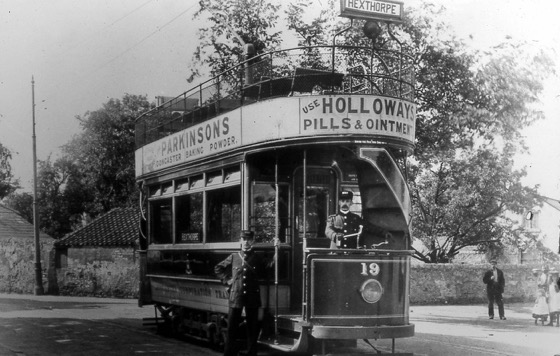
The crew of Tramcar No 19 pose for the cameraman at the Hexthorpe terminus in Bramworth Road — photo undated, but judging by the excellent condition of the tram, probably taken not long after this route opened in the summer of 1902. Author's Collection.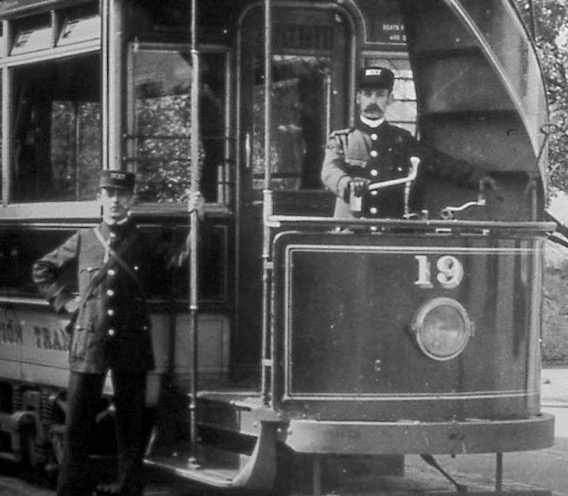
An enlargement of the above photograph showing the crew, both of whom are wearing single-breasted jackets (seemingly without insignia of any kind), along with kepi-style caps. The latter appear to bear one-piece, block-capital badges, probably 'DCT'.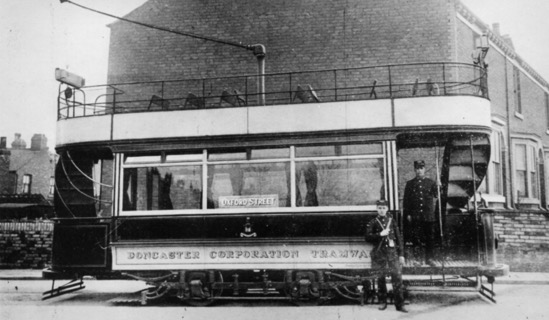
The crew of a pristine-looking example of one of Doncaster's open-topped tramcars, at the short-lived Oxford Street terminus — photo undated, but almost certainly taken in late 1903 or 1904. Photo courtesy of the Tramways and Light Railway Society, with thanks to David Voice.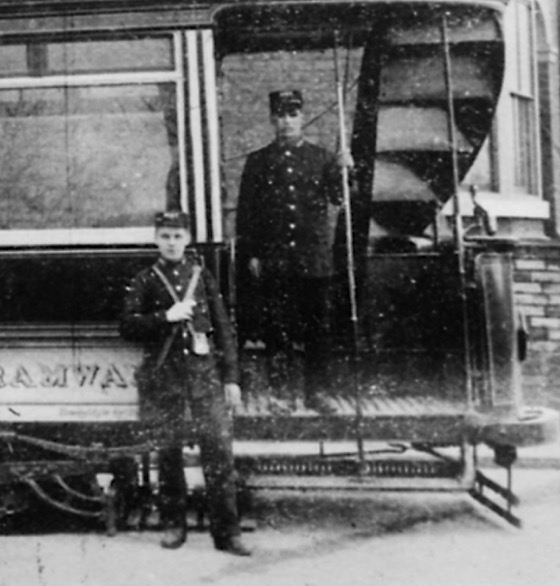
An enlargement of the above photograph showing the conductor, Thomas Jenkinson, and the motorman, Jack Haggitt. In contrast to the preceding photograph, the tunic collars appear to be carrying badges of some kind.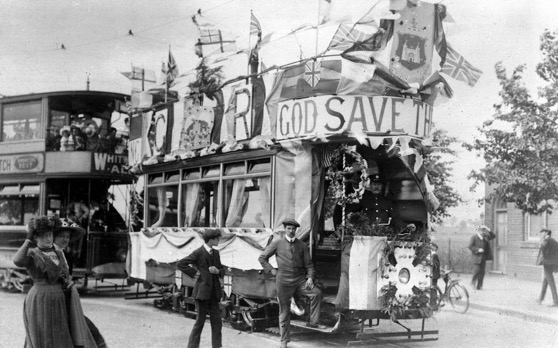
Tramcar No 21, heavily decorated, is pictured on the circular track at the Racecourse on Coronation Day 1911. Photo courtesy of the John Law Collection.
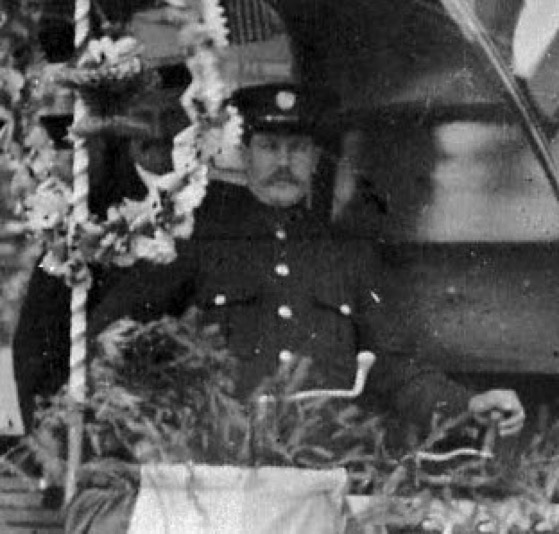
An enlargement of the above photograph showing the motorman. By this time, the caps had clearly been changed to a tensioned-crown peaked type, with a new municipal cap badge (see below for an example).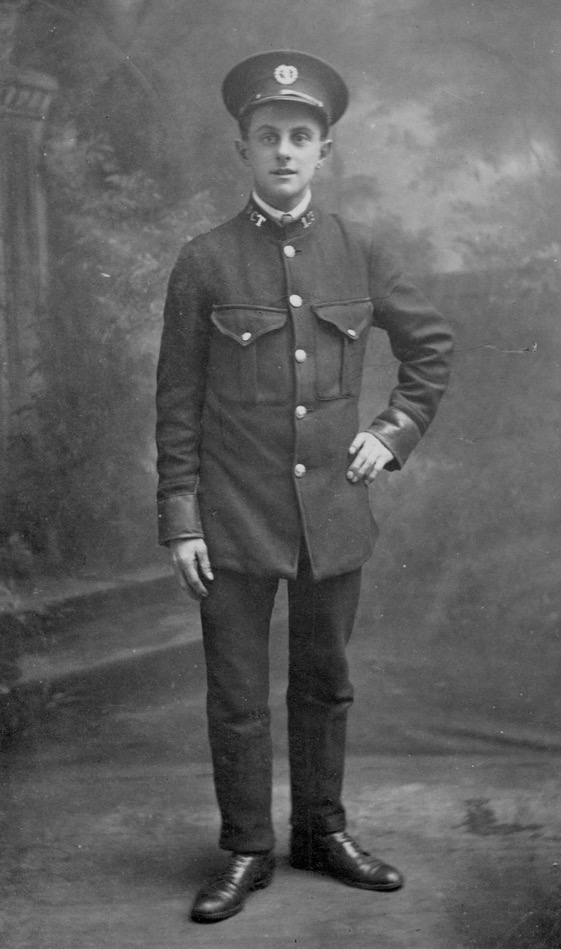
A rare studio portrait of a Doncaster Corporation Tramways uniformed employee – photo undated, but probably taken between 1910 and 1918. Author's Collection.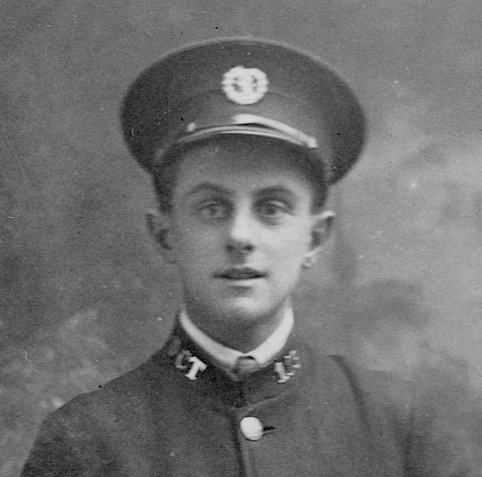
An enlargement of the above photograph, which though slightly out of focus, is still good enough to discern the collar and cap insignia. The collar badges are made up of individual system initials ('D C T') and numerals ('1x3', possibly '133').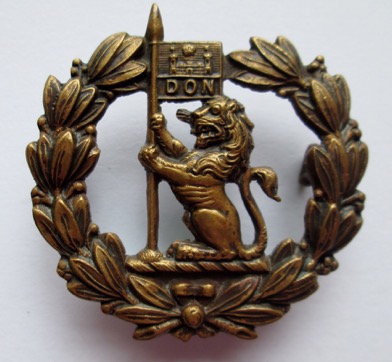
Doncaster Corporation municipal-device badge — brass — as worn by DCT tramcar crews on their caps from around the mid-Edwardian era until closure. Stephen Howarth Collection.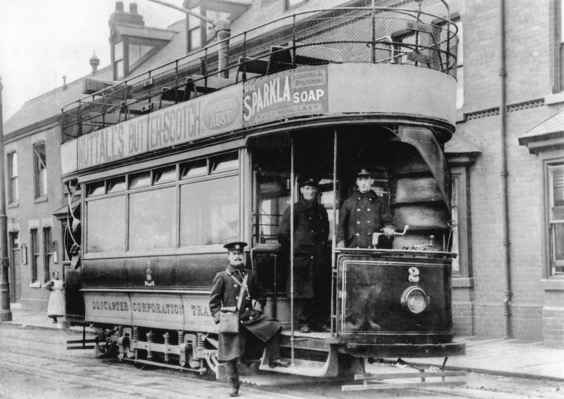
A conductor, an inspector and a motorman with Tramcar No 2 at the Hyde Park Road terminus near Chequer Road — photo undated, but probably taken some time between 1911 and the outbreak of the Great War. Author's Collection.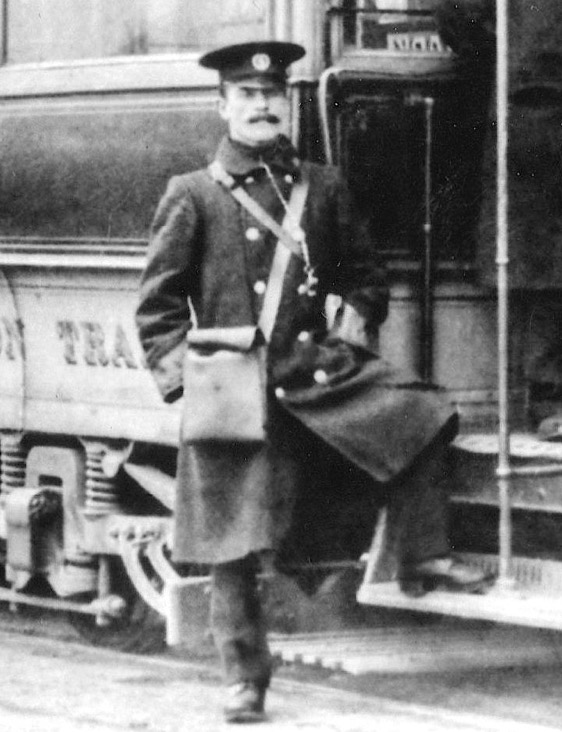
An enlargement of the above photograph showing the conductor — the distinctive shape of his municipal cap badge is just about discernible. Other than the buttons, the greatcoat appears to be completely devoid of insignia.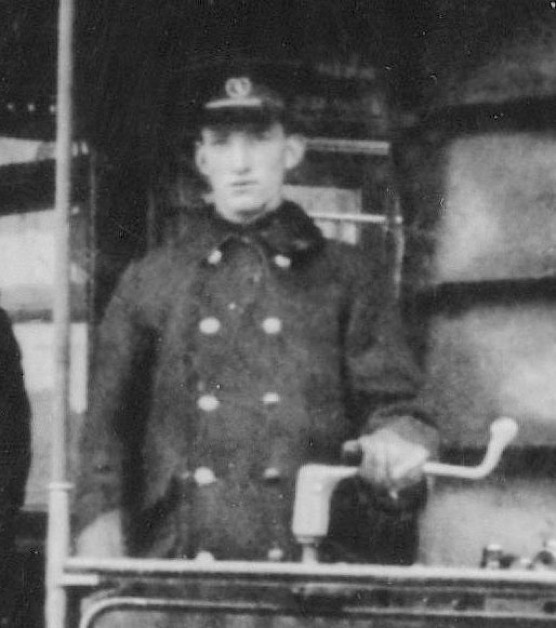
Another blow-up of the above photograph, this time showing the motorman, Horace Briggs.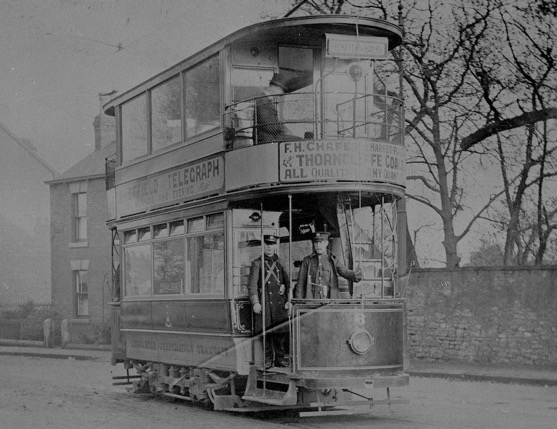
The crew of Tramcar No 6 at Balby, originally an open-topped vehicle, but here with top cover fitted — photo undated, but probably taken between 1910 and the outbreak of the Great War. Photo courtesy of the National Tramway Museum. 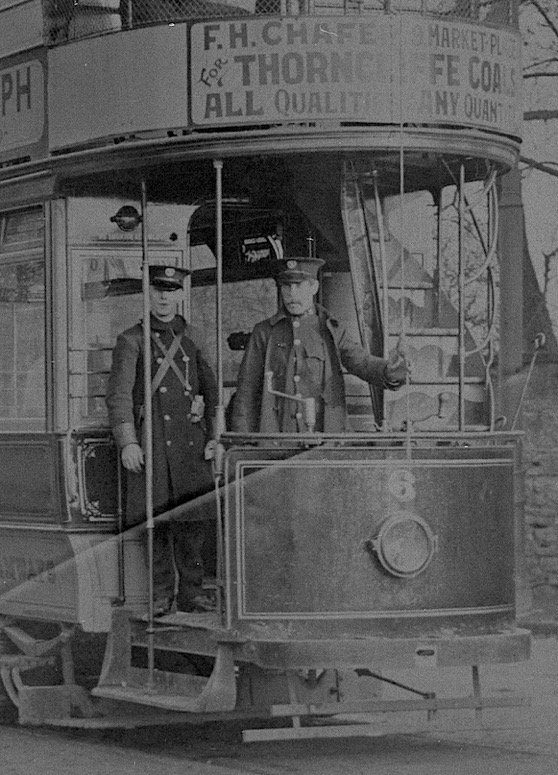
An enlargement of the above photograph showing the crew in greater detail.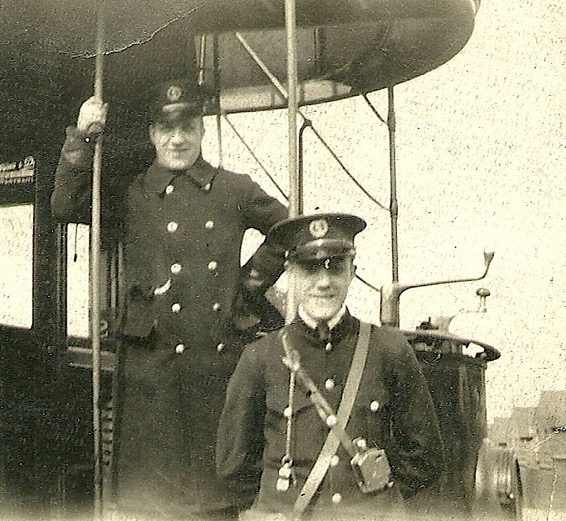
A motorman and a conductor with an unidentified tramcar — photo undated, but probably taken in the late 1920s or early 1930s. Once again, the subjects' collars appear to be without badges of any kind. Stephen Howarth Collection.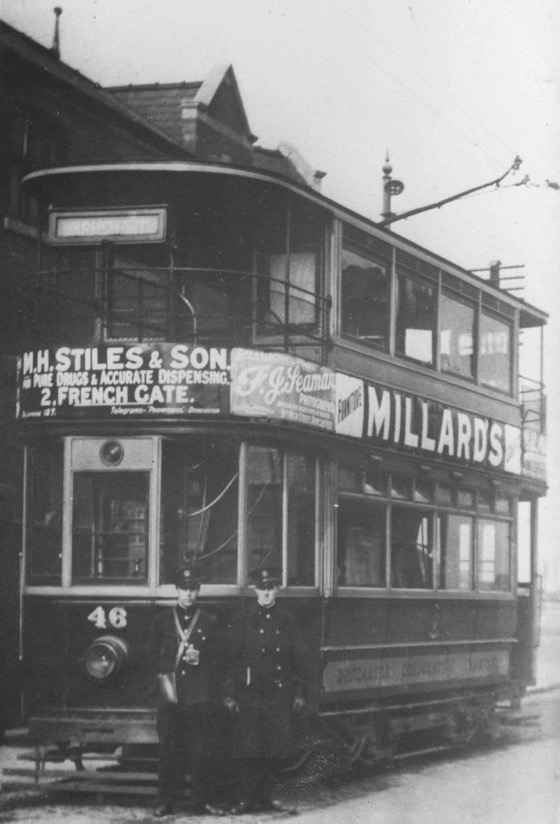
The crew of Tramcar No 46 pose for the camera at the Warmsworth terminus — photo undated, but probably taken in the late 1920s or early 1930s. Photo courtesy of the National Tramway Museum. 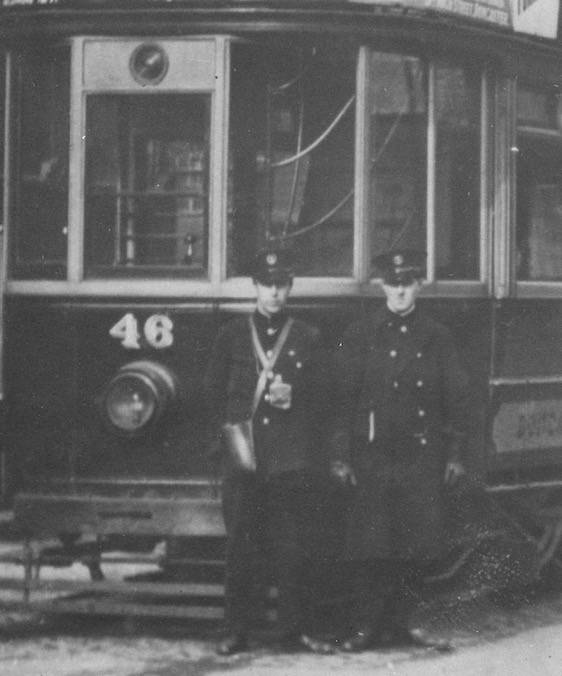
An enlargement of the above photograph showing the crew in greater detail. 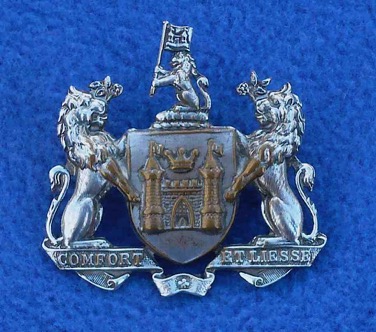
Doncaster Corporation Transport cap badge — chrome. The use of chroming as a badge material only became widespread in the late 1930s (see link), which along with the motto (granted in 1927), make it highly unlikely that this pattern of badge was ever issued to tramway staff; furthermore, there is no photographic evidence whatsoever to support its use.
Senior staff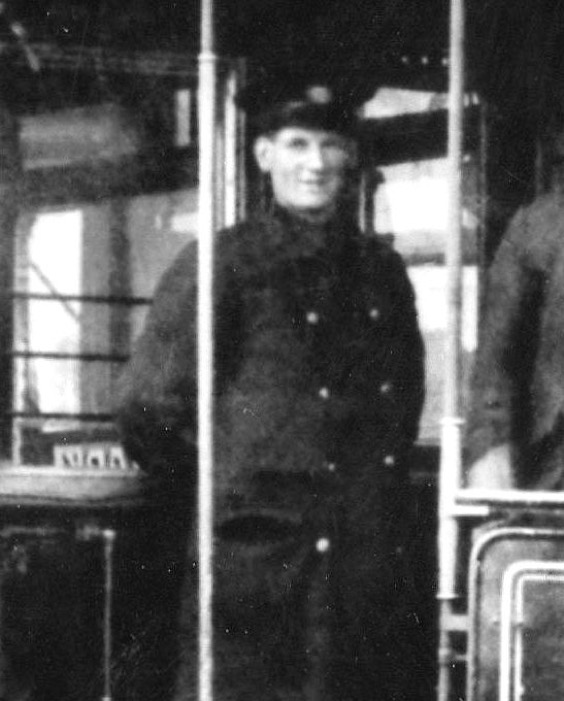
An enlargement of the photograph of Tramcar No 2 above showing the inspector. The cap badge is probably of the type depicted below.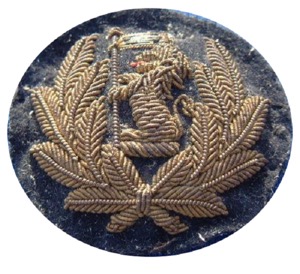
Doncaster Corporation Tramways inspector's cap badge — bullion-embroidered cloth. Photo courtesy of the Stephen Howarth Collection.
Female staff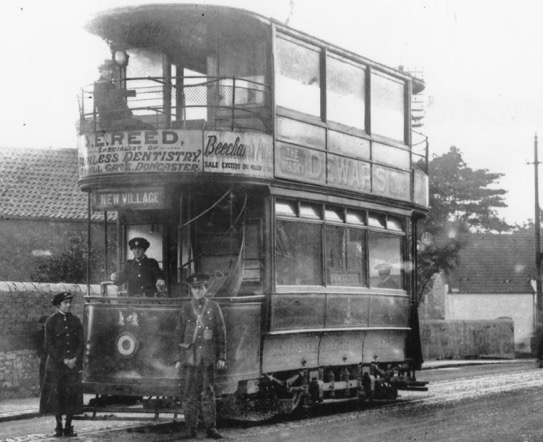
A Great War view of a rather dilapidated-looking Tramcar No 14 at the Bentley terminus. Author's Collection.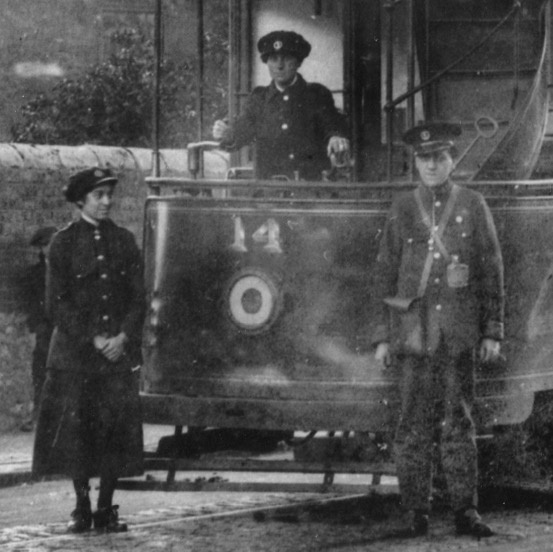
An enlargement of the above photograph showing the conductor and two female members of staff, one clearly a motorwoman. Both the ladies are wearing baggy motor caps.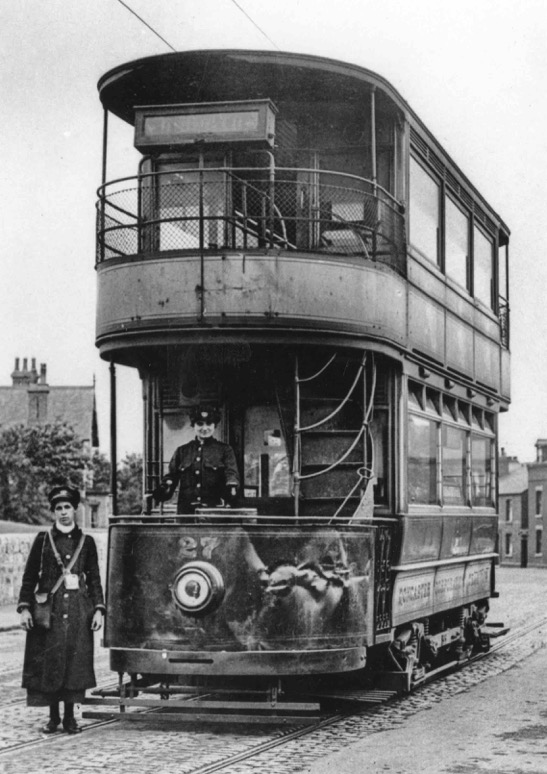
A conductress and a motorwoman pose with a spectacularly battered Tramcar No 27 at Oswin Avenue in 1917. Author's Collection.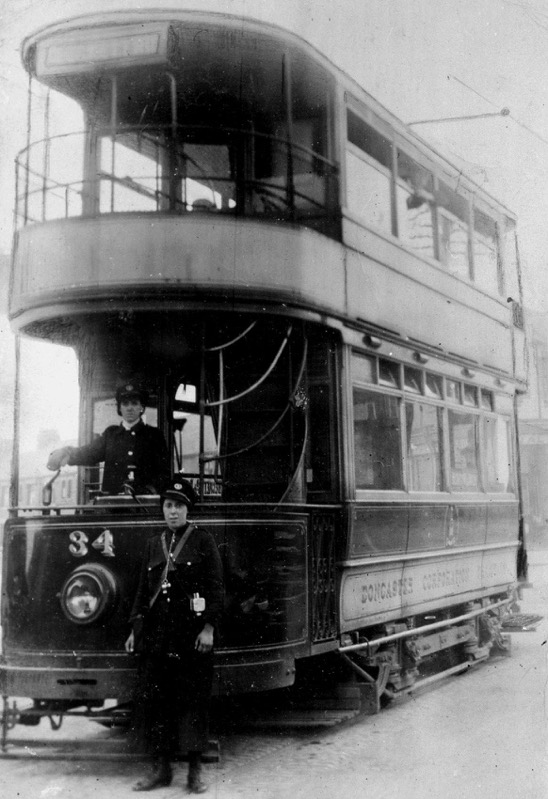
Another all-female Great War tram crew, this time captured at the Warmsworth terminus in 1917. John Law Collection.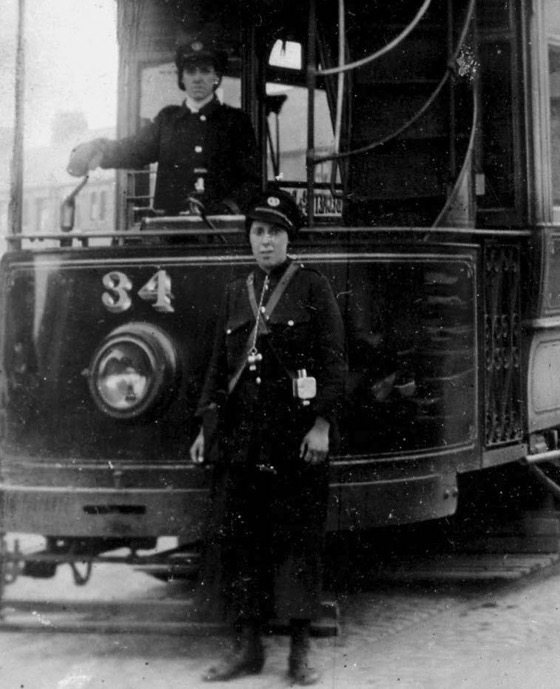
An enlargement of the above photograph showing the motorwoman and the conductress, neither of whom appear to be all that thrilled at having their images captured for posterity!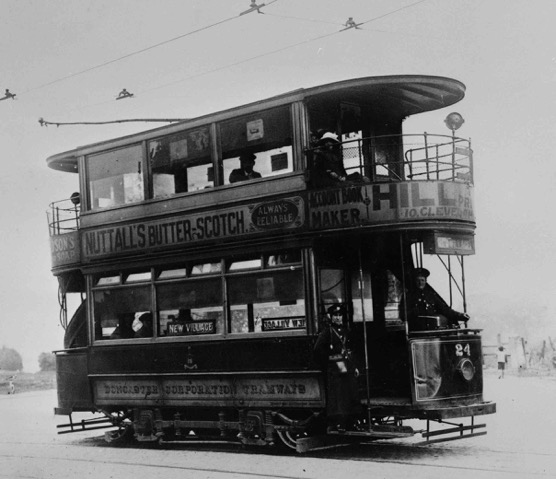
Tramcar No 24, captured at the passing loop not far from the Bentley terminus — photo undated, but certainly taken during the Great War or shortly afterwards. Photo by Luke Bagshaw, courtesy of the National Tramway Museum. 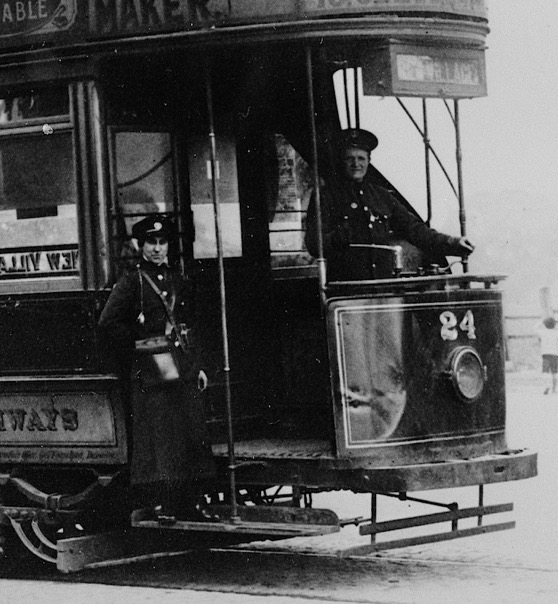
An enlargement of the above photograph showing the conductress and her male colleague.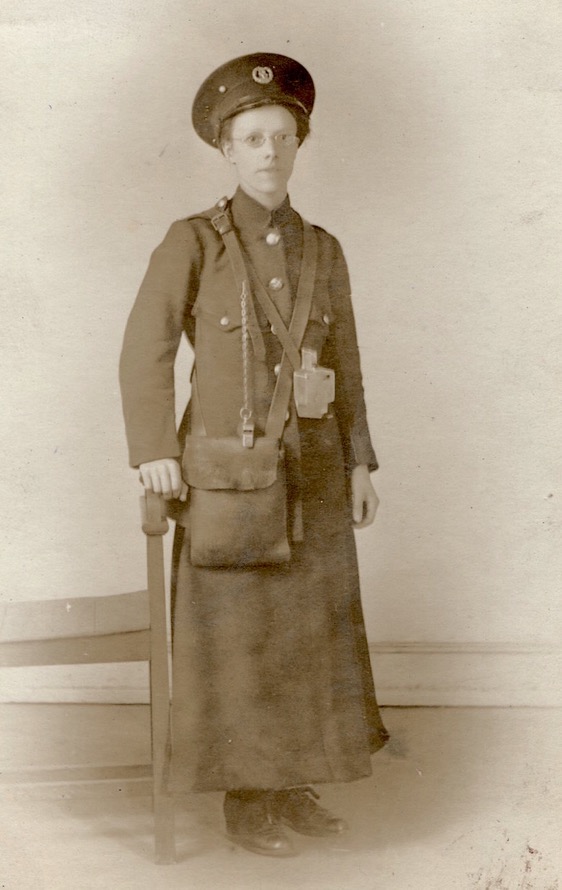
A studio portrait of a Great War Doncaster Corporation Tramways conductress. Unlike the photos above, the subject is wearing a peaked cap with a wide crown (top). Author's Collection.